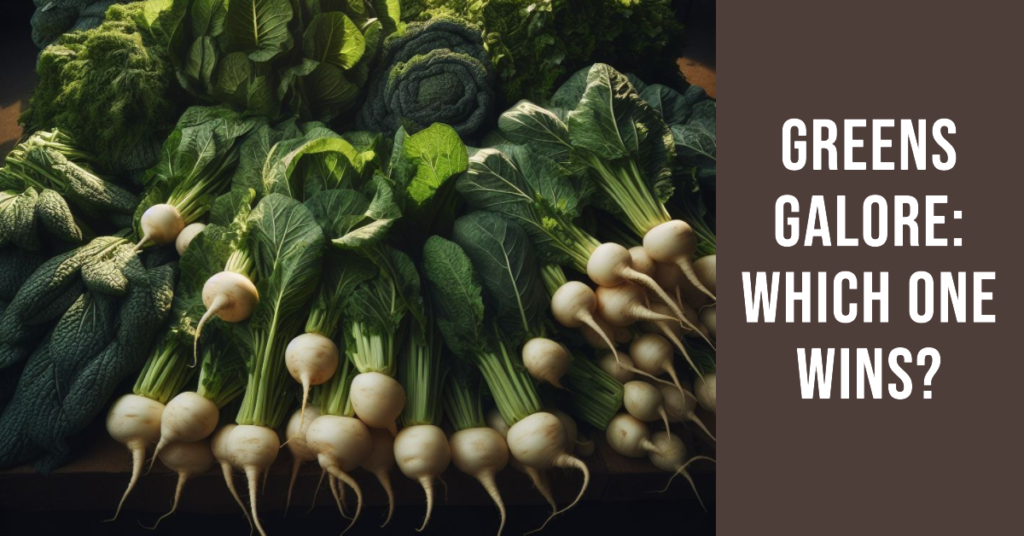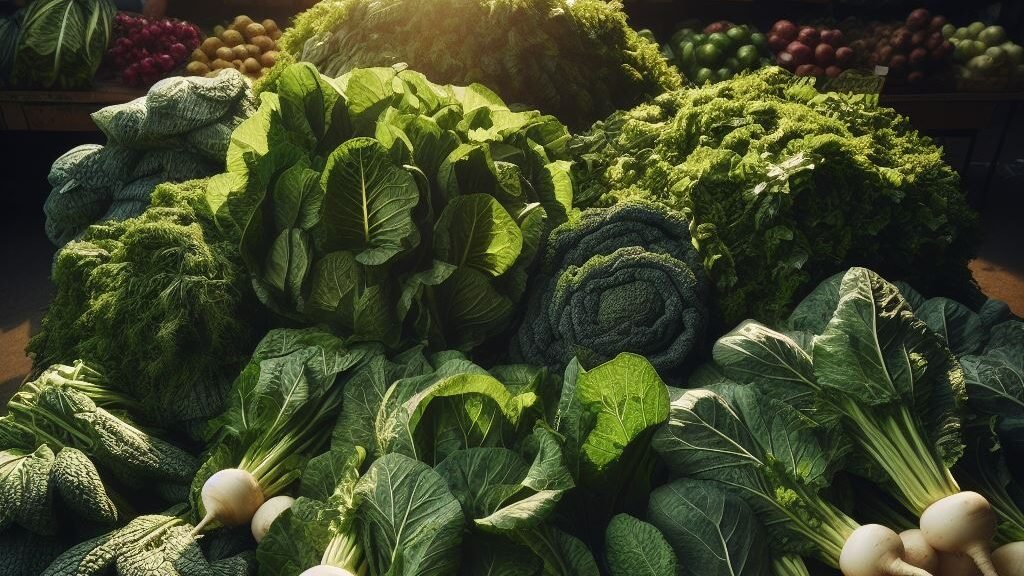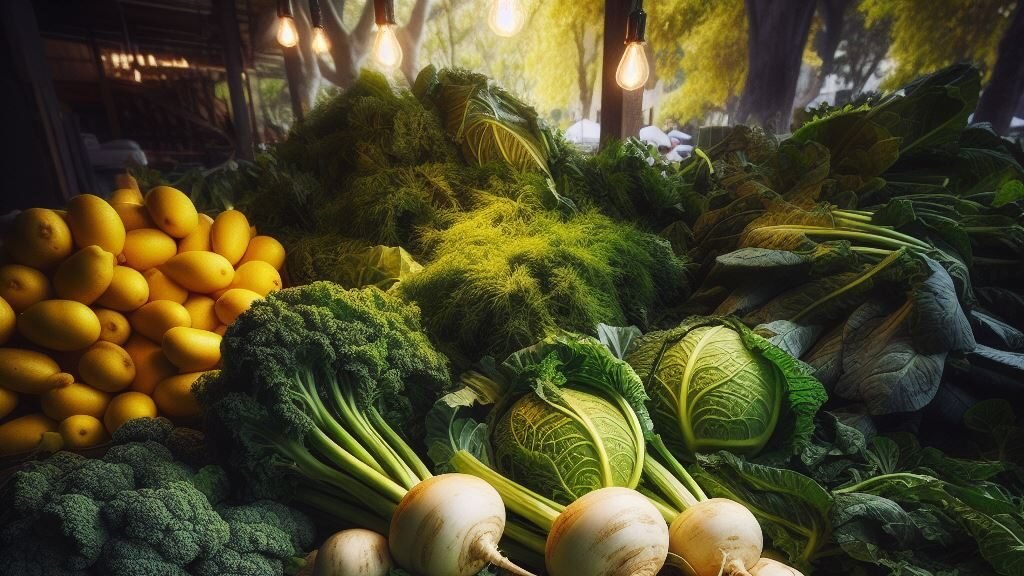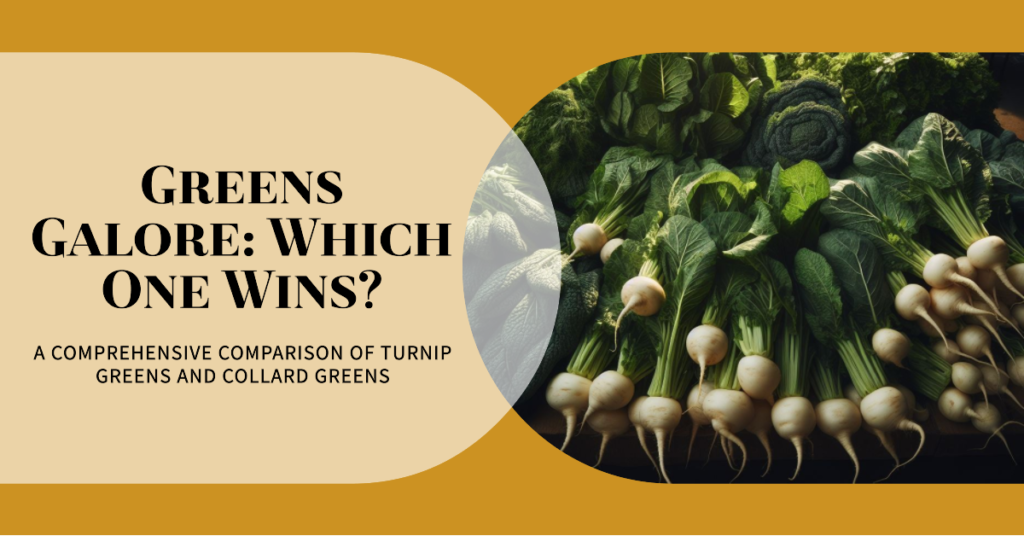When it comes to nutritious leafy greens, two contenders often come up for comparison – Turnip Greens and Collard Greens. Both are packed with health benefits and are staples in various cuisines, but how do they differ? This article delves into the nutritional showdown between Turnip Greens and Collard Greens, exploring their unique characteristics, health benefits, and culinary uses.”
Turnip Greens Vs Collard Greens: A Comprehensive Comparison
Turnip Greens and Collard Greens are both members of the Brassica family, known for their hearty leaves and nutrient-dense profiles. Turnip Greens, the leafy tops of the turnip plant, are slightly more delicate and have a slightly sweet, peppery taste. In terms of nutritional benefits, they are rich in vitamins A, C, and K, and are a good source of calcium, folate, and fiber.

On the other hand, Collard Greens have a mildly bitter taste and are typically larger and tougher than Turnip Greens. They are also nutritionally packed, providing a good source of vitamins A, C, K, and B6, calcium, and dietary fiber. They may also have slightly higher protein content than Turnip Greens.
Understanding Turnip Greens

Description and Characteristics of Turnip Greens
Turnip Greens are the leafy tops of the turnip plant, which is part of the cruciferous vegetable family. They can be identified by their dark green leaves with purple veins and stems. Turnip Greens have a slightly more delicate texture compared to Collard Greens and have a hint of sweetness along with a peppery taste.
Nutritional Profile of Turnip Greens
Turnip Greens are a nutritional powerhouse, providing several essential vitamins and minerals. One cup of cooked Turnip Greens contains 41 calories, 3 grams of protein, 0.5 grams of fat, and 8 grams of carbohydrates. They are particularly rich in vitamin A, providing over six times the recommended daily intake. They also contain high levels of vitamins C and K, providing more than 50% of the recommended daily intake. Additionally, Turnip Greens are a good source of calcium and folate.
Culinary Uses of Turnip Greens
Turnip Greens are a versatile leafy green that can be used in various dishes. They can be enjoyed raw in salads or lightly sautéed as a side dish. Turnip Greens can also be added to soups, stews, and stir-fries for a flavorful and nutritious boost. They are also a popular ingredient in traditional Southern recipes, such as Turnip Green Dip and Turnip Green Casserole.
Understanding Collard Greens

Description and Characteristics of Collard Greens
Collards have large, dark green leaves with thick stems and a slightly bitter taste. They are a member of the Brassica family, making them closely related to Turnip Greens, Brussels Sprouts, and Kale. Collard Greens have a chewier texture compared to Turnip Greens and require longer cooking times.
Nutritional Profile of Collard Greens
Similar to Turnip Greens, Collards are packed with essential nutrients. One cup of cooked Collard Greens contains 49 calories, 4 grams of protein, 0.6 grams of fat, and 9 grams of carbohydrates. They are an excellent source of vitamins A, C, K, and B6. Additionally, they provide a good amount of calcium and dietary fiber.
Culinary Uses of Collard Greens
Collard Greens are a staple in Southern cuisine, where they are often slow-cooked with ham hocks or bacon for added flavor. They can also be used in traditional dishes such as Hoppin’ John and Collard Green Wraps. Additionally, Collards are commonly used as a wrap or substitute for tortillas or bread due to their large size and sturdy texture.
Nutritional Comparison: Turnip Greens Vs Collard Greens
| Nutrient | Turnip Greens (per 100g) | Collard Greens (per 100g) |
|---|---|---|
| Calories (Kcal) | 32 | 32 |
| Protein (g) | 1.5 | 3.02 |
| Total Fat (g) | 0.3 | 0.61 |
| Carbohydrates (g) | 7.13 | 5.42 |
| Dietary Fiber (g) | 3.2 | 4.0 |
| Sugars (g) | 0.8 | 0.46 |
| Calcium (mg) | 190 | 232 |
| Iron (mg) | 1.10 | 0.47 |
| Magnesium (mg) | 31 | 27 |
| Phosphorus (mg) | 42 | 25 |
| Potassium (mg) | 203 | 213 |
| Sodium (mg) | 58 | 17 |
| Zinc (mg) | 0.27 | 0.20 |
| Vitamin C (mg) | 60 | 35.3 |
| Thiamin (mg) | 0.090 | 0.050 |
| Riboflavin (mg) | 0.110 | 0.140 |
| Niacin (mg) | 0.400 | 0.500 |
| Vitamin B-6 (mg) | 0.220 | 0.200 |
| Folate (µg) | 118 | 129 |
| Vitamin A (IU) | 11587 | 3804 |
| Vitamin E (mg) | 2.86 | 1.73 |
| Vitamin K (µg) | 251.3 | 437.1 |
Sources:
- USDA National Nutrient Database for Turnip Greens
- USDA National Nutrient Database for Collard Greens.
Vitamins and minerals comparison:
- Turnip Greens: higher in vitamins A and K, calcium, and folate
- Collard Greens: higher in vitamin B6 and protein
Fiber and protein content comparison:
- Both Turnip and Collard Greens provide a good source of dietary fiber
- Collard Greens may have slightly higher protein content than Turnip Greens
Taste and Texture: Turnip Greens Vs Collard Greens
Differences in taste:
- Turnip Greens: slightly sweet, peppery taste
- Collard Greens: mildly bitter taste
Differences in texture:
- Turnip Greens: delicate and tender
- Collard Greens: tough and chewy
Cooking Techniques for Turnip Greens and Collard Greens
Best ways to prepare Turnip Greens:
- Raw in salads
- Lightly sautéed as a side dish
- Added to soups, stews, and stir-fries
Best ways to prepare Collard Greens:
- Slow-cooked with meat for added flavor
- Used as a wrap or substitute for tortillas/bread
Health Benefits of Turnip Greens and Collard Greens
Health benefits of Turnip Greens:
- Rich in antioxidants, particularly beta-carotene
- May help improve eye health and promote healthy skin
- Good source of calcium for bone health
Health benefits of Collard Greens:
- High levels of vitamin C may support a healthy immune system
- May aid in digestion due to high fiber content
- Good source of folate, which is important for fetal development during pregnancy
Summary

Turnip Greens:
- Taste: Turnip greens have a sharper, somewhat sweeter taste than collard greens.
- Nutrition: They are high in vitamins A, C, and K, and also contain significant amounts of calcium and potassium. They also provide a good amount of fiber and are low in calories.
- Cooking: Turnip greens tend to cook down significantly, so you might need more than you think to make a substantial dish. They can be sautéed, boiled, or used in soups and stews.
- Availability: They are typically available year-round but are at their peak from October through March.
Collard Greens:
- Taste: Collard greens have a slightly bitter, smoky flavor. They’re less peppery than turnip greens.
- Nutrition: Collards are rich in vitamins K, A, and C, and also provide a good amount of fiber, calcium, and vitamin E. They’re also low in calories.
- Cooking: Collard greens are traditionally slow-cooked with a piece of smoked meat (like ham hock) until they’re soft and tender. They can also be sautéed, used in salads, or added to soups and stews.
- Availability: Collard greens are a cool-weather vegetable, and their flavor is said to improve after a frost. They’re typically available year-round but are at their peak from January through April.
Both turnip greens and collard greens can be a healthy addition to any diet as they’re low in calories and packed with vitamins and minerals. The choice between the two often comes down to personal preference in terms of flavor and texture.
Conclusion: Which is Better, Turnip Greens or Collard Greens?
When determining whether Turnip Greens or Collard Greens are better, it comes down to individual preferences and nutritional needs. If you are looking for a leafy green that is slightly sweet and tender, and higher in vitamins A and K, calcium, and folate, then Turnip Greens may be the better choice for you. On the other hand, Collard Greens offer a more robust, chewy texture, higher levels of vitamin B6 and protein, and a mildly bitter taste that pairs well with various ingredients. Both greens offer significant health benefits, including boosting the immune system, promoting eye and skin health, aiding in digestion, and supporting bone health. Whichever you choose, both greens make a nutritious and flavorful addition to your diet.
Frequently Asked Questions (FAQs)
Are Turnip Greens and Collard Greens interchangeable in recipes?
Although they have different flavors and textures, Turnip Greens and Collard Greens can be used interchangeably in many recipes. However, it’s important to note that Collard Greens are tougher and may require a longer cooking time.
Which is more calorie-dense: Turnip Greens or Collard Greens?
Both Turnip Greens and Collard Greens are low in calories. One cup of cooked Turnip Greens contains 41 calories, while the same serving of cooked Collard Greens contains 49 calories.
Can people with dietary restrictions consume Turnip Greens and Collard Greens?
Yes, both greens are suitable for individuals following vegan, vegetarian, gluten-free, and low-carb diets.
Which is a better source of Vitamin C: Turnip Greens or Collard Greens?
Both greens are high in Vitamin C, but Turnip Greens contain more than 50% of the recommended daily intake, making them a richer source.
Are these greens seasonal or available year-round?
While they may be most abundant and flavorful during the cooler months, both Turnip Greens and Collard Greens are generally available year-round in many grocery stores.





